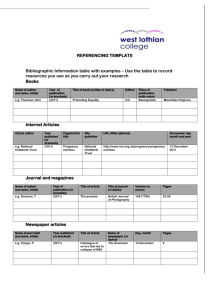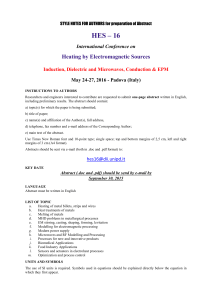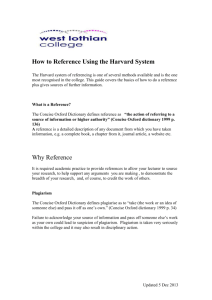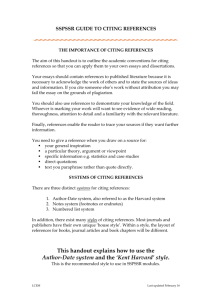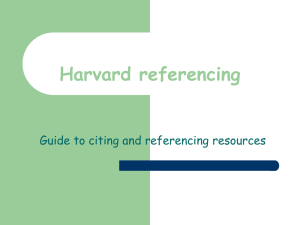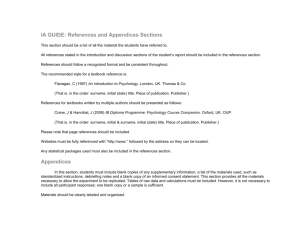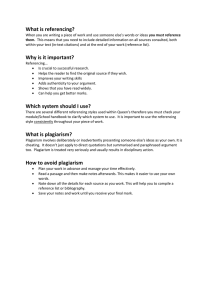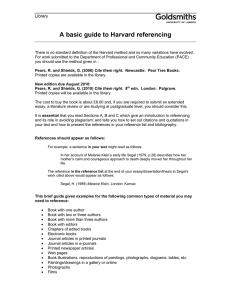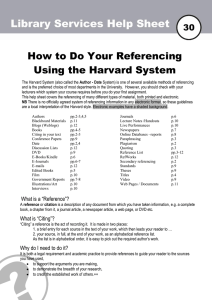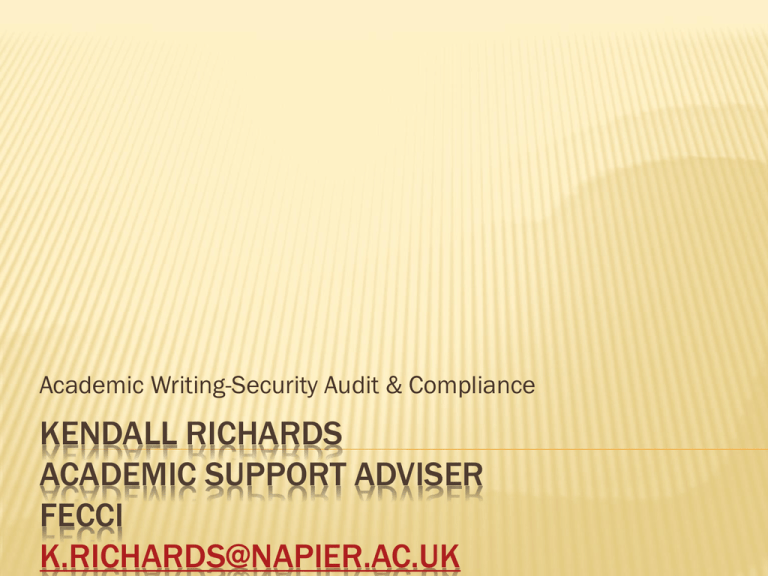
Academic Writing-Security Audit & Compliance
KENDALL RICHARDS
ACADEMIC SUPPORT ADVISER
FECCI
K.RICHARDS@NAPIER.AC.UK
COURSEWORK REQUIREMENTS
BRAINSTORM TIME.
What are the main principles/elements
required for this academic writing?
Differences between academic and business
writing?
What do we look for?
PRINCIPLES OF ACADEMIC COMMUNICATION
Honesty-state only that which can be supported
Reality-be clear and direct in style and aims
and objectives
Relevance
IMRAD AND ABSTRACTS
Many scientific reports follow the IMRaD format:
Introduction, Methods, Results, and Discussion.
The IMRAD format has been adopted by an increasing
number of academic journals.
Before the introduction , in these journals there is
always a title and abstract.
An abstract is a brief summary of a research article,
thesis, review, conference proceeding.
The abstract succinctly communicates complex
research.
Usually the first place a person looks to ascertain
whether they will read on any further.
Suggested report structure
Executive Summary 150-200 words outlining the
contents of the report.
Introduction Giving an overview of the aim and scope of
the paper and making it clear which business sector
you have selected.
Background covering the history and motivations
behind data protection law and an overview of the
factors relevant to the sector you have chosen
Discussion and analysis, including an overview of how
data protection law has been applied in the sector, the
detailed evaluation of impact of data protection law on
the sector, implications for security policies and
possible future developments in the area.
Conclusions, and limitations of work. The limitations
section should include consideration of the
effectiveness of the research approach you used.
You should use the supplied rubric as guidance on the
marking expectations. Remember to bear in mind their
relative marking weights.
STYLE?
Formal?
Objective?
Structured?
Your final document should use a formal style - this means writing impersonally. All sources
used must be formally acknowledged through citations and a reference list.
Suggested report structure
THE BASICS OF GOOD WRITING STYLE, CONTD.
Write words out in full, for instance use ‘do not’
instead of ‘don’t’.
Do use appropriate technical terms, but consider the
expertise of your audience and include a Terms of
Reference section in the introduction, so you can
explain the technical terms you are using.
Avoid superfluous words and aim for a clear,
explanatory written style.
WRITING ACADEMICALLY:
Be objective – don’t present unsupported or personal opinions.
Take a balanced view.
Be accurate – give clear non-subjective and definite figures (‘after
twenty five minutes’, ‘80% of the participants’). Avoid vague or
ambiguous terms like ‘a long period of time’, or ‘most of the
participants’.
Be direct – don’t leave it to your reader to work out what you are
saying! Putting the emphasis on a strong verb can help the reader
to see the important points: for instance, ‘an analysis was
performed on the results’ is not as direct as ‘the results were
analysed’.
Be critical – evaluate your own work as well as that of others. Have
the confidence to say if something could have been done better, if
done differently.
Be appropriate – assume your audience is interested and
educated, but give them the information they need to understand
your work.
CONVENTIONS OF ACADEMIC WRITING
Do not use the personal pronouns ‘I’, ‘we’ , ‘you’, etc. Instead
of ‘I did x’, use ‘x was done’.
Be cautious rather than direct or emphatic (use terms such
as ‘appears to’, ‘may’ and ‘seems to’. Try to avoid
‘definitely’, ‘always’, and ‘very’).
Be moderate and dispassionate rather than emotional or
rhetorical. Avoid terms such as ‘nice’, ‘natural’, ‘great’,
‘wonderful’.
Avoid using questions as section headings. Instead of ‘Why
did Royal Bank of Scotland choose to use SAP-R/3?’, use
‘Reasons for the use of SAP-R/3 by Royal Bank of Scotland’.
ACADEMIC PHRASEBANK
TASK ANALYSIS
Marking grid
Abstract, Introduction and contextual discussion
Wtg
20
Research activity, range of materials used and topic coverage.
20
Synthesis and analysis of the main issue under discussion.
25
Discussion of topic, conclusions drawn (including any recommendations) and critical evaluation.
25
Presentation and readability, structure, referencing
10
Total
100
Grade
LITERATURE REVIEW/BACKGROUND
Scholarly review of literature
An appraisal not narrative
Context/background/definitions
Identify common and divergent themes
HOW MIGHT CRITICAL THINKING BE
APPLIED TO MY ESSAY?
Start with the analysis
Get authoritative sources
Compare and contrast
Be reflective when writing
HOW WILL YOU SHOW THAT THE FOLLOWING
HAVE BEEN DONE:
Meets the specification given
Treats topics in depth
Is evaluative/analytical rather than descriptive
Justifies/illustrates its arguments well
Uses an impersonal/academic writing style
Is fluent, succinct and grammatical
Has few spelling / typing errors
Is well set out in an appropriate format
Organises the material appropriately
Uses a good range of appropriate sources
Consistently applies an approved referencing system
Descriptive
Critical/Analytical
State what happened?
Identifies significance
State what something is like?
Evaluates strengths/weaknesses
Give the story?
Briefly summarise and highlight significant
events
State the order in which events occurred?
Suggests why these events occurred
Note the method used?
Discusses whether the method worked and
why/not
Say when something occurred?
Identifies why timing is significant
List details?
Evaluates significance of details
State links between items?
Shows relevance of links
Give information?
Draws conclusions
HOW DO I DO THIS?
What am I looking at?
Why am I looking at this?
So what?
USE GRIDS TO PLAN WRITING.
Themes/Concepts
Diary
Presentation
Module
Case study
WHAT IS PLAGIARISM?
Plagiarism is to take someone else’s words or
ideas and present them as your own without
proper acknowledgement (Marshall and
Rowland, 1998)
REFERENCING
References are published sources of information that
you have used in coursework and dissertations.
Referencing lends your work authority, by showing off
how much reading and research you have conducted.
You always get credit for including appropriate and
accurate references.
References should be:
relevant to the topic you are researching,
from a reputable academic journal, book, textbook
as up-to-date as possible
A REFERENCE LIST
is a list of all the sources that you have directly referred to.
It is always presented in alphabetical order of author
surnames.
Only include sources which you have used.
Use one system for citing these sources, consistently and
accurately.
You should not use bullets points, nor numbers, for the
references in your list.
A BIBLIOGRAPHY
is a list of everything you read for the report, whether or not
you have directly referred to it in your writing.
This is required in addition to your reference list.
It is presented in alphabetical order of author surname.
Use the same system for citing these sources, as in the
reference list.
HOW TO AVOID PLAGIARISM
You must acknowledge the source of any ideas that are not
your own.
You must show the source of any direct quotations. These are
word-for-word quotations place within “
”.
You must also acknowledge the source of indirect quotations.
This is material that you have changed into your own words,
paraphrased or summarised.
Referencing a book with a single author
Author’s surname
Place of publication
Year of publication
in brackets
Reynolds, G. (2010). Ethics in Information Technology. Boston: Cengage
Learning.
Author’s initial
The short in-text reference is
Title in
italics
Name of publisher
(Reynolds, 2010)
Book with multiple authors in a later edition
Author’s surname
Author’s initial
Year of publication
in brackets
Title in
italics
McNurlin, B., Sprague, R. and Bui, T. (2009). Information systems
management in practice (8th ed.). New Jersey: Pearson/Prentice Hall.
Edition
Author’s surname
and initial
Place of publication
(McNurlin, Sprague & Bui, 2009)
(McNurlin et al., 2009)
The first short in-text reference is
Subsequent references are
Name of publisher
Article accessed from a web page
Organisation as
author
Title in
italics
Year of publication
in brackets
Business Link (2010). New guidance on how your business can use
cloud computing. [Electronic version] Retrieved 10th August 2011 from
http://www.businesslink.gov.uk/bdotg/action/layer?topicId=1084685982
Electronic resource
in square brackets
Full URL
Date you found the
article
If from an online journal, add journal title, volume, issue & page details.
The short in-text reference is
(Business Link, 2010)
Journal article accessed from a database
Author’s surname
and initial
Year of publication
in brackets
Article
title
• Phan, D. & Vogel, D. (2010). A model of customer relationship
management and business intelligence systems for catalogue and
online retailers. Information & Management, 47(2), pp.69-77.
Retrieved August 12th, 2011 from the Science Direct database.
Journal
title in
italics
The short in-text reference is
Date retrieved &
name of database
(Phan & Vogel, 2010)
Volume, issue in
brackets, and
page numbers
Article from a magazine or newspaper
Author’s surname
and initial
Year , month and
date of publication
in brackets
Article
title
Rawsthorn, A. (1990, December 24). Conditions tougher for textile
industry. Financial Times,p.5.
Newspaper or
magazine title in
italics
The short in-text reference is
page number(s)
(Rawsthorn, 1990)
Essay within an edited book
Essay author’s
surname and
initial
Year of
publication
in brackets
Book editor’s
surname and
initial (Ed)
Essay
title
Birch, K. (2009). Social entrepreneurship. In Deakins, D. (Ed),
Enterpreneurship and small firms (pp. 248-261). London: Butterworth.
Book title
in italics
page numbers of
essay in brackets
The short in-text reference is
(Birch, 2009)
Place of publication
and name of
publisher

